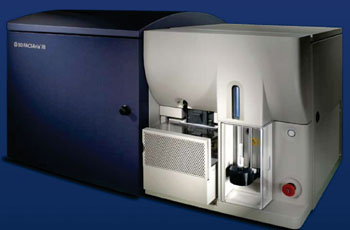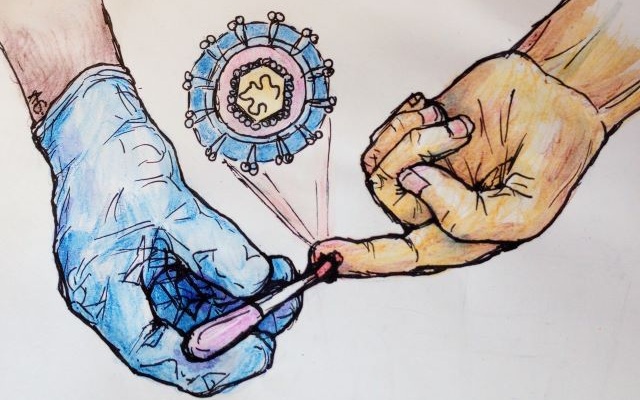Immune Cells Adapt Inefficiently in Patients with Uncontrolled HIV
|
By LabMedica International staff writers Posted on 28 Mar 2016 |
Antibodies derived from a type of immune cell found in unusually high numbers in human immunodeficiency virus (HIV)-infected individuals with chronically uncontrolled virus levels are less effective at neutralizing HIV than antibodies derived from a different type of immune cell more common in people without HIV.
HIV infection leads to numerous immunologic abnormalities, especially in individuals whose viremia is not well controlled, either naturally or by antiretroviral therapy (ART). B cells are not direct targets for HIV replication; however, direct and indirect consequences of viral replication such as immune activation and lymphopenia lead to numerous B cell abnormalities over the course of infection.
Scientists at the US National Institute of Allergy and Infectious Diseases (Bethesda, MD, USA) and their colleagues collected serum and/or leukapheresis products from 25 chronically infected HIV-viremic individuals. The donors were not taking antiretroviral drugs to suppress the level of HIV in their blood, or viral load, at the time of the study. Like many individuals with persistent levels of HIV, the donors' blood samples had abnormally high numbers of immune cells called tissue-like memory (TLM) B cells, compared with resting memory (RM) B cells, which account for the majority of memory B cells in people without HIV.
Peripheral blood mononuclear cells (PBMCs) were obtained by density-gradient centrifugation. Mature CD10-B cells were isolated from PBMCs by negative magnetic bead–based selection using a B cell enrichment cocktail that was supplemented with tetrameric anti-CD10 monoclonal antibodies (mAb) (STEMCELL Technologies; Vancouver, BC, Canada). Immunophenotyping to identify suitable subjects for sorting was performed using the following anti-human mAbs. Fluorescent activated cell sorting (FACS) analyses were performed on a FACSCanto II flow cytometer and sorting of B cell populations and of single HIV-specific B cells into 96-well polymerase chain reaction (PCR) plates was performed on a modified 3-laser FACSAria instrument (BD Biosciences; San Jose, CA, USA).
Generally, as B cells divide in response to a pathogen like HIV, genes that produce infection-fighting antibodies mutate, and descendant cells producing the most effective antibodies predominate. Despite the fact that TLM B cells generally divided more frequently than their RM counterparts, the scientists found that the antibodies derived from TLM B cells showed genetic evidence of fewer adaptive mutations than those derived from RM B cells. In turn, these antibodies were less likely to effectively neutralize HIV than those derived from RM B cells. The RM B cells, in contrast, showed evidence of generating antibodies with more helpful mutations.
The authors concluded that nonconventional TLM B cells overrepresented in the peripheral blood of chronically infected HIV-viremic individuals show reduced affinity maturation compared with their clonally related conventional RM counterparts, despite evidence of having undergone more cell divisions. The study was published on March 17, 2016, in the journal JCI Insight.
Related Links:
US National Institute of Allergy and Infectious Diseases
STEMCELL Technologies
BD Biosciences
HIV infection leads to numerous immunologic abnormalities, especially in individuals whose viremia is not well controlled, either naturally or by antiretroviral therapy (ART). B cells are not direct targets for HIV replication; however, direct and indirect consequences of viral replication such as immune activation and lymphopenia lead to numerous B cell abnormalities over the course of infection.
Scientists at the US National Institute of Allergy and Infectious Diseases (Bethesda, MD, USA) and their colleagues collected serum and/or leukapheresis products from 25 chronically infected HIV-viremic individuals. The donors were not taking antiretroviral drugs to suppress the level of HIV in their blood, or viral load, at the time of the study. Like many individuals with persistent levels of HIV, the donors' blood samples had abnormally high numbers of immune cells called tissue-like memory (TLM) B cells, compared with resting memory (RM) B cells, which account for the majority of memory B cells in people without HIV.
Peripheral blood mononuclear cells (PBMCs) were obtained by density-gradient centrifugation. Mature CD10-B cells were isolated from PBMCs by negative magnetic bead–based selection using a B cell enrichment cocktail that was supplemented with tetrameric anti-CD10 monoclonal antibodies (mAb) (STEMCELL Technologies; Vancouver, BC, Canada). Immunophenotyping to identify suitable subjects for sorting was performed using the following anti-human mAbs. Fluorescent activated cell sorting (FACS) analyses were performed on a FACSCanto II flow cytometer and sorting of B cell populations and of single HIV-specific B cells into 96-well polymerase chain reaction (PCR) plates was performed on a modified 3-laser FACSAria instrument (BD Biosciences; San Jose, CA, USA).
Generally, as B cells divide in response to a pathogen like HIV, genes that produce infection-fighting antibodies mutate, and descendant cells producing the most effective antibodies predominate. Despite the fact that TLM B cells generally divided more frequently than their RM counterparts, the scientists found that the antibodies derived from TLM B cells showed genetic evidence of fewer adaptive mutations than those derived from RM B cells. In turn, these antibodies were less likely to effectively neutralize HIV than those derived from RM B cells. The RM B cells, in contrast, showed evidence of generating antibodies with more helpful mutations.
The authors concluded that nonconventional TLM B cells overrepresented in the peripheral blood of chronically infected HIV-viremic individuals show reduced affinity maturation compared with their clonally related conventional RM counterparts, despite evidence of having undergone more cell divisions. The study was published on March 17, 2016, in the journal JCI Insight.
Related Links:
US National Institute of Allergy and Infectious Diseases
STEMCELL Technologies
BD Biosciences
Read the full article by registering today, it's FREE! 

Register now for FREE to LabMedica.com and get access to news and events that shape the world of Clinical Laboratory Medicine. 
- Free digital version edition of LabMedica International sent by email on regular basis
- Free print version of LabMedica International magazine (available only outside USA and Canada).
- Free and unlimited access to back issues of LabMedica International in digital format
- Free LabMedica International Newsletter sent every week containing the latest news
- Free breaking news sent via email
- Free access to Events Calendar
- Free access to LinkXpress new product services
- REGISTRATION IS FREE AND EASY!
Sign in: Registered website members
Sign in: Registered magazine subscribers
Latest Immunology News
- Ultrasensitive Liquid Biopsy Demonstrates Efficacy in Predicting Immunotherapy Response
- Blood Test Could Identify Colon Cancer Patients to Benefit from NSAIDs
- Blood Test Could Detect Adverse Immunotherapy Effects
- Routine Blood Test Can Predict Who Benefits Most from CAR T-Cell Therapy
- New Test Distinguishes Vaccine-Induced False Positives from Active HIV Infection
- Gene Signature Test Predicts Response to Key Breast Cancer Treatment
- Chip Captures Cancer Cells from Blood to Help Select Right Breast Cancer Treatment
- Blood-Based Liquid Biopsy Model Analyzes Immunotherapy Effectiveness
- Signature Genes Predict T-Cell Expansion in Cancer Immunotherapy
- Molecular Microscope Diagnostic System Assesses Lung Transplant Rejection
- Blood Test Tracks Treatment Resistance in High-Grade Serous Ovarian Cancer
- Luminescent Probe Measures Immune Cell Activity in Real Time
- Blood-Based Immune Cell Signatures Could Guide Treatment Decisions for Critically Ill Patients
- Novel Tool Predicts Most Effective Multiple Sclerosis Medication for Patients
- Companion Diagnostic Test for CRC Patients Identifies Eligible Treatment Population
- Novel Tool Uses Deep Learning for Precision Cancer Therapy
Channels
Clinical Chemistry
view channel
Blood Test Could Predict and Identify Early Relapses in Myeloma Patients
Multiple myeloma is an incurable cancer of the bone marrow, and while many patients now live for more than a decade after diagnosis, a significant proportion relapse much earlier with poor outcomes.... Read more
Compact Raman Imaging System Detects Subtle Tumor Signals
Accurate cancer diagnosis often depends on labor-intensive tissue staining and expert pathological review, which can delay results and limit access to rapid screening. These conventional methods also make... Read moreMolecular Diagnostics
view channel
Blood Test Combined with MRI Brain Scans Reveals Two Distinct Multiple Sclerosis Types
Multiple sclerosis (MS) affects more than 2.8 million people worldwide, yet predicting how the disease will progress in individual patients remains difficult. Current MS classifications are based on clinical... Read more
Ultra-Sensitive Blood Biomarkers Enable Population-Scale Insights into Alzheimer’s Pathology
Accurately estimating how many people carry Alzheimer’s disease pathology has long been a challenge, as traditional methods rely on small, clinic-based samples rather than the general population.... Read more
Blood Test Could Predict Death Risk in World’s Most Common Inherited Heart Disease
Hypertrophic cardiomyopathy (HCM) is the world’s most common inherited heart condition and affects millions of people globally. While some patients live with few or no symptoms, others develop heart failure,... Read moreHematology
view channel
MRD Tests Could Predict Survival in Leukemia Patients
Acute myeloid leukemia is an aggressive blood cancer that disrupts normal blood cell production and often relapses even after intensive treatment. Clinicians currently lack early, reliable markers to predict... Read more
Platelet Activity Blood Test in Middle Age Could Identify Early Alzheimer’s Risk
Early detection of Alzheimer’s disease remains one of the biggest unmet needs in neurology, particularly because the biological changes underlying the disorder begin decades before memory symptoms appear.... Read more
Microvesicles Measurement Could Detect Vascular Injury in Sickle Cell Disease Patients
Assessing disease severity in sickle cell disease (SCD) remains challenging, especially when trying to predict hemolysis, vascular injury, and risk of complications such as vaso-occlusive crises.... Read more
ADLM’s New Coagulation Testing Guidance to Improve Care for Patients on Blood Thinners
Direct oral anticoagulants (DOACs) are one of the most common types of blood thinners. Patients take them to prevent a host of complications that could arise from blood clotting, including stroke, deep... Read moreMicrobiology
view channel
New UTI Diagnosis Method Delivers Antibiotic Resistance Results 24 Hours Earlier
Urinary tract infections affect around 152 million people every year, making them one of the most common bacterial infections worldwide. In routine medical practice, diagnosis often relies on rapid urine... Read more
Breakthroughs in Microbial Analysis to Enhance Disease Prediction
Microorganisms shape human health, ecosystems, and the planet’s climate, yet identifying them and understanding how they are related remains a major scientific challenge. Even with modern DNA sequencing,... Read morePathology
view channel
Genetics and AI Improve Diagnosis of Aortic Stenosis
Aortic stenosis is a progressive narrowing of the aortic valve that restricts blood flow from the heart and can be fatal if left untreated. There are currently no medical therapies that can prevent or... Read more
AI Tool Simultaneously Identifies Genetic Mutations and Disease Type
Interpreting genetic test results remains a major challenge in modern medicine, particularly for rare and complex diseases. While existing tools can indicate whether a genetic mutation is harmful, they... Read more
Rapid Low-Cost Tests Can Prevent Child Deaths from Contaminated Medicinal Syrups
Medicinal syrups contaminated with toxic chemicals have caused the deaths of hundreds of children worldwide, exposing a critical gap in how these products are tested before reaching patients.... Read more
Tumor Signals in Saliva and Blood Enable Non-Invasive Monitoring of Head and Neck Cancer
Head and neck cancers are among the most aggressive malignancies worldwide, with nearly 900,000 new cases diagnosed each year. Monitoring these cancers for recurrence or relapse typically relies on tissue... Read moreTechnology
view channel
Pioneering Blood Test Detects Lung Cancer Using Infrared Imaging
Detecting cancer early and tracking how it responds to treatment remains a major challenge, particularly when cancer cells are present in extremely low numbers in the bloodstream. Circulating tumor cells... Read more
AI Predicts Colorectal Cancer Survival Using Clinical and Molecular Features
Colorectal cancer is one of the most common and deadly cancers worldwide, and accurately predicting patient survival remains a major clinical challenge. Traditional prognostic tools often rely on either... Read moreIndustry
view channel
BD and Penn Institute Collaborate to Advance Immunotherapy through Flow Cytometry
BD (Becton, Dickinson and Company, Franklin Lakes, NJ, USA) has entered into a strategic collaboration with the Institute for Immunology and Immune Health (I3H, Philadelphia, PA, USA) at the University... Read more





















